By Evelyn Nguyen, Mar 17, 2025
“There might be few nations in the world where the people cherish their national flag as much as the Vietnamese. I have traveled extensively, but nowhere have I seen such deep affection for the national flag as in Vietnam”, shared John, a British journalist residing in Vietnam on his social media.
Indeed, when you visit Vietnam, after setting foot, you will immediately notice the Red Flag with a Yellow Star flying proudly, not just on governmental buildings but also on the rooftops of many homes. So, what does the Vietnamese flag symbolize? If you're curious about this flag, let Incredible Asia Journeys guide you through the story behind the Red Star Flag - The Soul of Vietnam and What You Don't Know.
The Vietnamese flag is about a powerful symbol of the nation's pride, history, and resilience. Let's explore the Vietnamese flag meaning and origins!
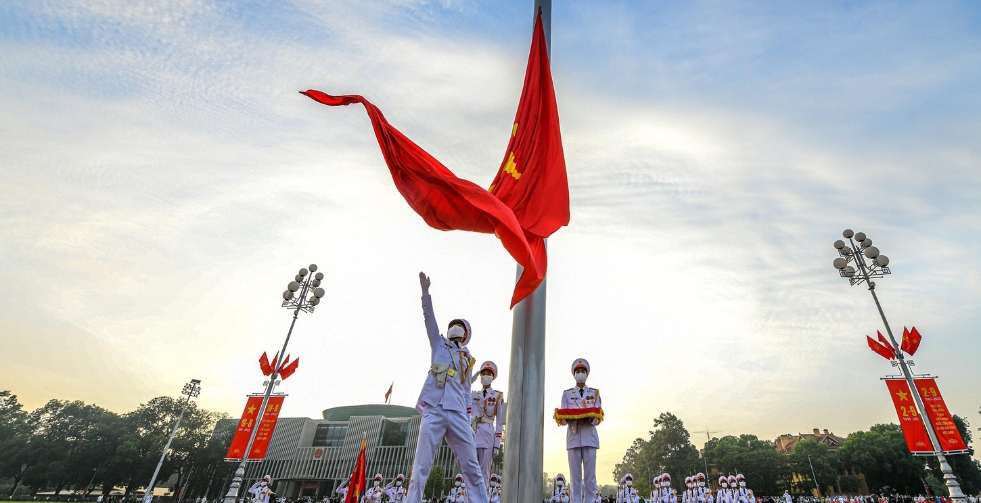
Vietnam flag raising in Ba Dinh Spare
The Vietnam flag's design, a yellow star on a red background, was officially adopted on September 5, 1945. So, why is the Vietnamese flag red and yellow? The red represents the bloodshed in the struggle for independence, symbolizing the revolutionary zeal of the Vietnamese people. About the yellow star, while yellow in the Vietnamese flag colors represents the Vietnamese race's skin color, its five points symbolize the unity of soldiers, intellectuals, workers, peasants, and youth in building socialism.
Thus, we can get the Vietnam flag explanation that the red background reflects the constant fight for freedom and the sacrifices made by those who sought independence for the nation. The yellow star in the center represents the guiding light of communism, under which all classes unite to form a socialist republic.
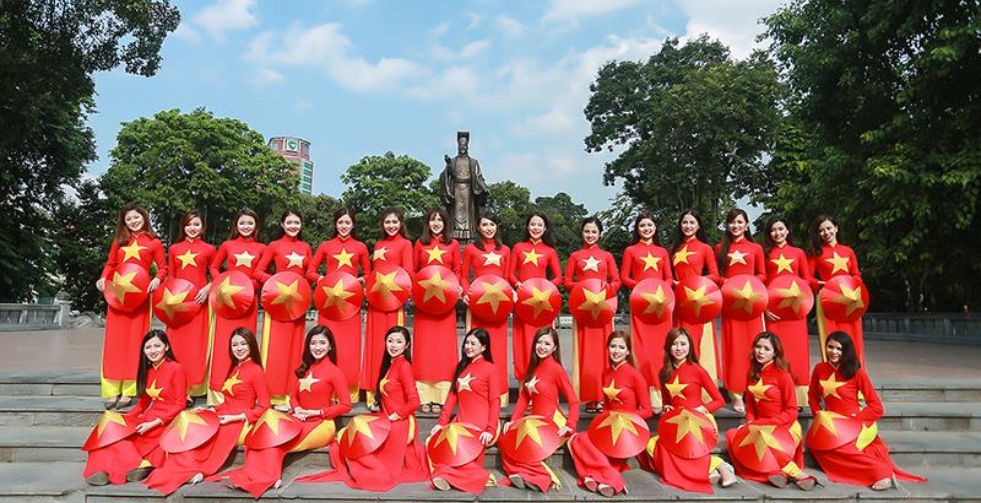
Ao Dai with Vietnam flag
As mentioned earlier, the Vietnamese people hold their national flag in high esteem. Incredible Asia Journeys will reveal some interesting facts about this iconic symbol!
The Vietnamese flag can be seen almost everywhere, but if you're looking to capture stunning photos with this symbol of national pride, be sure to add these locations to your Vietnam tour packages!
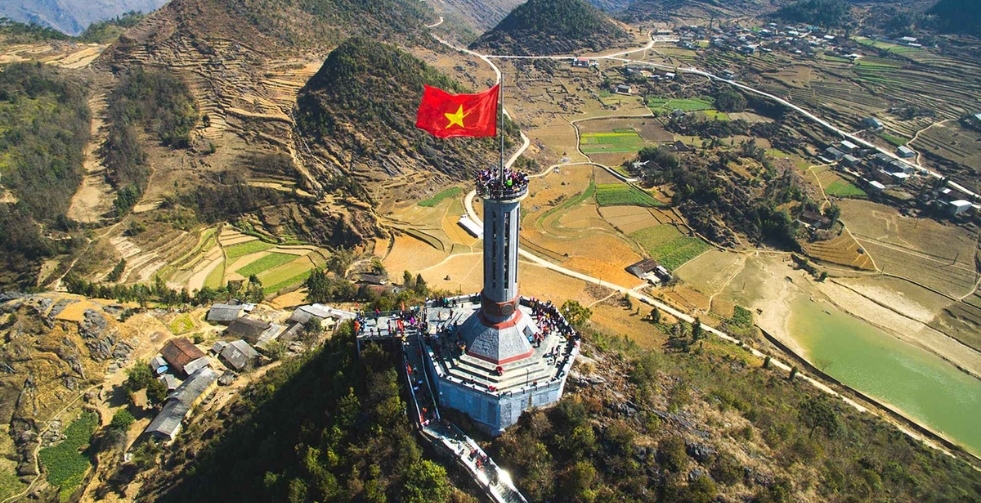
Lung Cu Flag Tower in Ha Giang
Located at the northernmost point, the Lung Cu Flag Tower stands as a symbol of Vietnam's national sovereignty. The flag atop Lung Cu Flag Tower waves proudly over the vast landscapes of Ha Giang.
This iconic site is a must-visit for anyone traveling to the Northern mountainous region of Vietnam. Visitors often include it as a highlight in their Ha Giang loop tour, combining the breathtaking views with the cultural and historical significance of this towering monument.

Fansipan Mount Peak in Sapa
Rising a high of 3,147 meters above sea level, Fansipan is known as the "Roof of Indochina" in Sapa. Visitors can reach the summit, whether by trekking or taking the cable car. At the peak, the Vietnamese flag stands tall against the sky, symbolizing the nation’s highest point. The sight of the flag amidst the clouds, with the mountainous landscape stretching out below, is both awe-inspiring and humbling.
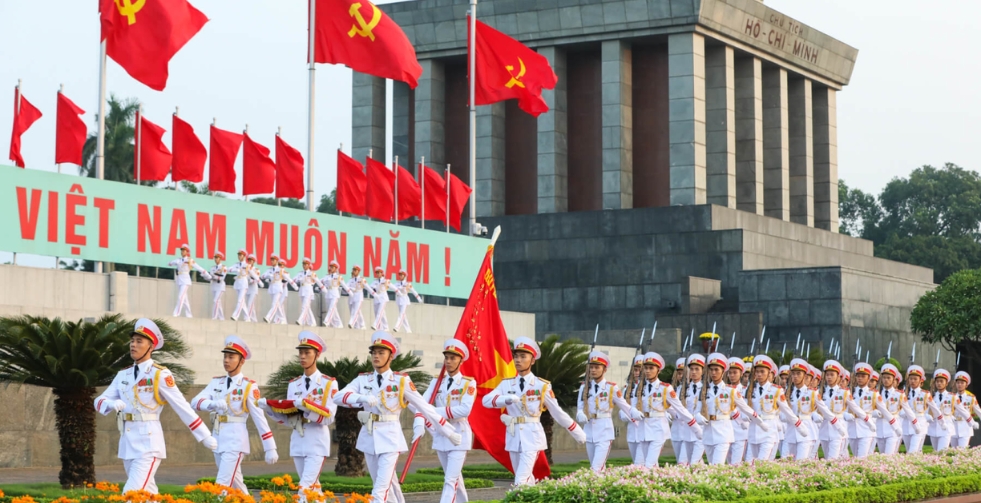
Ho Chi Minh Mausoleum in Hanoi
Another destination that cannot miss on any Vietnam tour is the Ho Chi Minh Mausoleum in Hanoi. Situated in Ba Dinh Square, where President Ho Chi Minh read the Declaration of Independence in 1945, the mausoleum is a solemn and sacred site.
The daily flag-raising and lowering ceremonies are conducted with military precision, accompanied by the national anthem. These ceremonies are deeply moving, providing a moment to reflect on the sacrifices made for the country's independence. You can come here at 6:00 A.M. and 9:00 P.M. to witness the flag-raising and lowering every day.
The Hue Flag Tower is another historical monument within the Hue Imperial Citadel, the former capital of Vietnam during the Nguyen Dynasty. This three-tiered flag tower has been a symbol of sovereignty and power since it was first erected in 1807.
The Vietnamese flag flying atop the flag tower can be seen from across Hue, especially during the numerous festivals and events held in the city. Visitors to the citadel can capture the flag against the backdrop of ancient walls and gates.
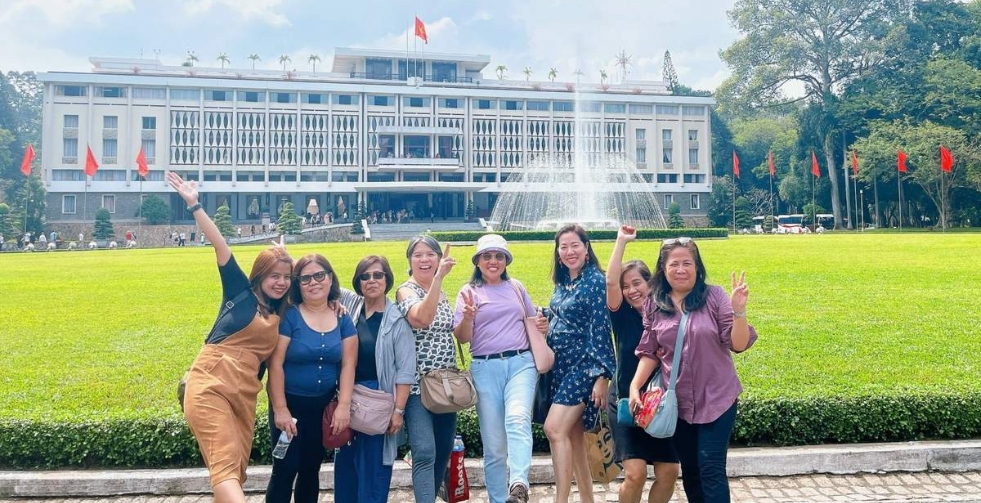
Independence Palace in Ho Chi Minh City
The Independence Palace is of great historical significance in Vietnam, particularly in Ho Chi Minh City. It was here that the Vietnam War effectively ended in 1975 when a North Vietnamese tank crashed through its gates.
These days, the palace is like a museum, and the Vietnamese flag waves proudly over it. That flag now stands for the victory of reunification and peace after lots of fighting. The palace grounds are perfect for taking photos, with the flag often in the background of the architecture and beautiful gardens.
At Vietnam’s southernmost tip, Ca Mau Cape marks the end of Vietnam vast S-shaped landmass. The Flag Tower in Ca Mau Cape is a symbolic flagpole that stands as a sentinel at this remote location.
The journey to Ca Mau Cape is an amazing adventure, taking travelers through the Mekong Delta’s labyrinth of rivers, mangroves, and swamps. Upon reaching the cape, the sight of the Vietnamese flag waving over the open sea is a reminder of the country’s geographical diversity.
If you want to experience the flag of Vietnam at its most vibrant and widespread, mark your calendar for these national holidays for Vietnam Tours. During these times, every corner of the country is adorned with the red and yellow of the national flag, from bustling city streets to quiet rural villages with many things to do & see in Vietnam.
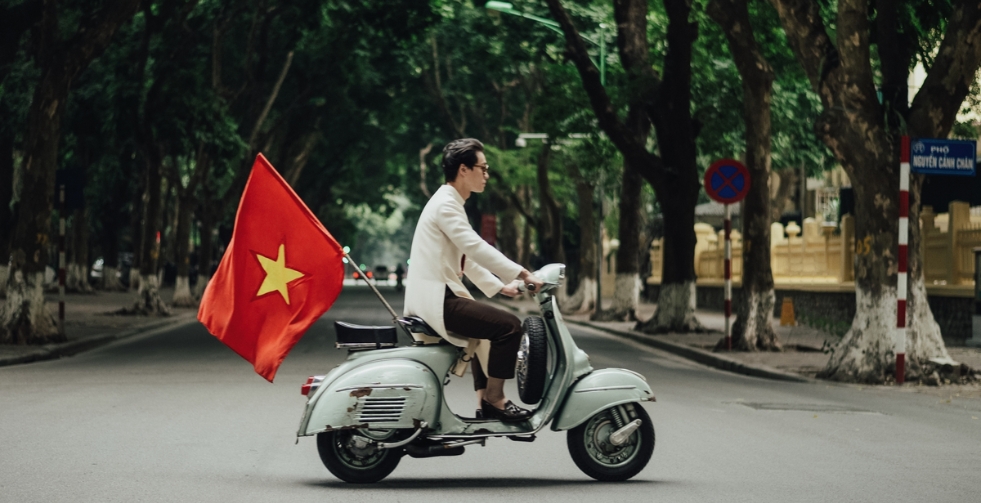
Vietnam people love their own national flag
Tet Holiday or Vietnamese Lunar New Year is usually between late January and mid-February, depending on the lunar calendar. This is the most significant holiday in Vietnam, and the entire country is enveloped in a festive atmosphere.
The Vietnamese flag is prominently displayed alongside traditional decorations like peach blossoms, kumquat trees, and red lanterns. In Hanoi Old Quarter, the flag flies proudly from almost every home and shop, creating a sea of red that symbolizes good fortune and prosperity for the new year.
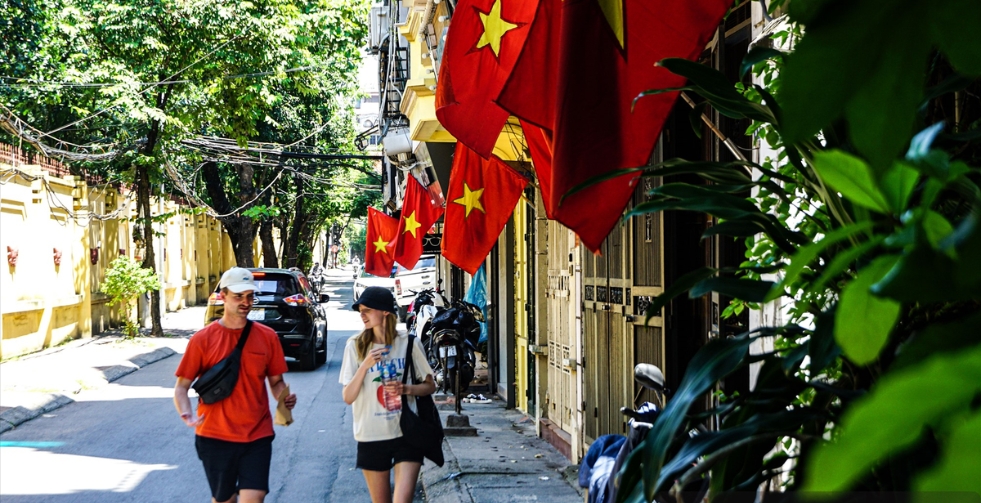
Vietnam flag in the street
Reunification Day on April 30th marks the end of the Vietnam War and the reunification of North and South Vietnam in 1975. This day, paired with International Workers' Day on May 1st, is a special occasion of Vietnam's national pride.
The Vietnamese flag is displayed in full force across the country, especially in major cities like Ho Chi Minh City and Hanoi. Streets, government buildings, and public spaces are draped in the national colors, and many places host parades, performances, and other celebrations.
Vietnam National Day on September 2nd is the anniversary of the country's declaration of independence from France in 1945. This is another key occasion when the Vietnamese flag is omnipresent, fluttering from every building, monument, and landmark.
Ba Dinh Square in Hanoi, where President Ho Chi Minh first declared independence, is a particular place to witness the flag-raising ceremony on this day. Throughout Vietnam, citizens will come together to celebrate with parades, fireworks, and cultural events, all under the banner of the national flag.
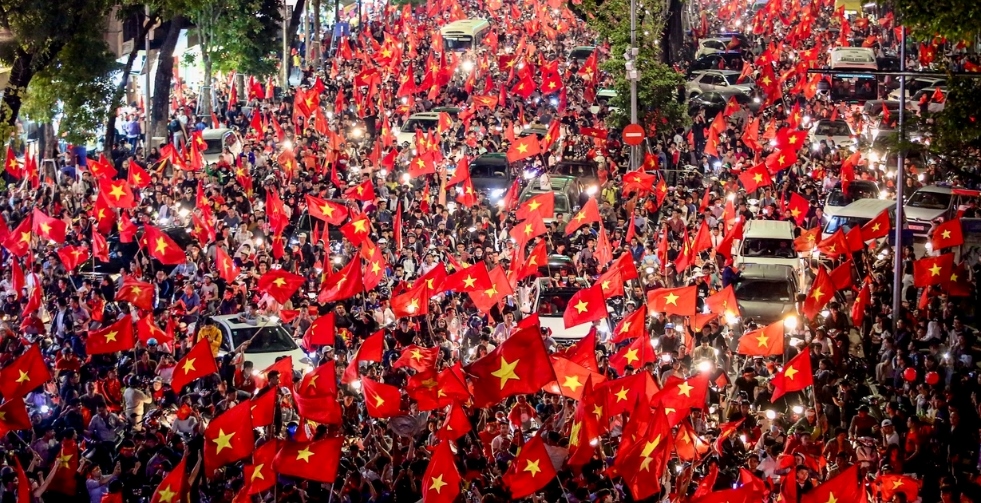
Vietnam people celebrate football champion with Vietnam flag
As a symbol of the nation, the Vietnamese flag is deeply significant to the people of Vietnam. If you’re a traveler who appreciates the cultural and historical richness of this country, it’s important to be mindful of the following points.
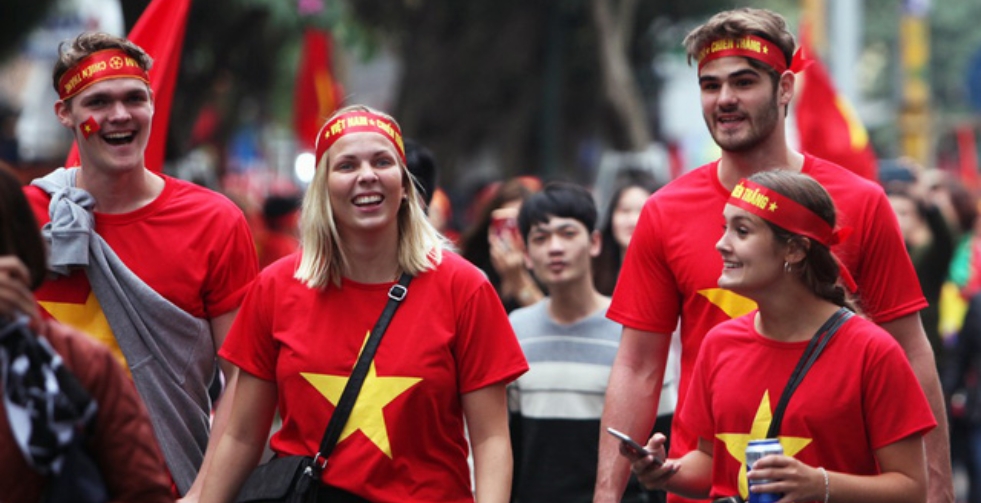
Tourists in Vietnam flag shirts
Through this Vietnam travel blog, we hope to untangle your curiosity about Vietnamese culture and history, as seen through the lens of the Vietnam national flag. Through countless ups and downs in history, the flag has always flown proudly, serving as a source of pride for every citizen.
When you visit Vietnam, you'll feel the sacredness of the flag in every street, every home, and in the hearts of every Vietnamese person. Contact Incredible Asia Journeys to explore the beauty of Vietnam and appreciate the meaning of the red star flag!